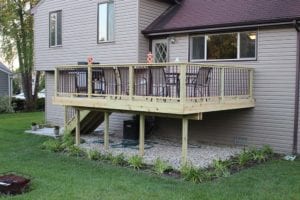
Deck materials. So many choices…which one is right for you? Don’t let the choice overwhelm you! We’ll give you the pros and cons of each type so that you can make a more informed decision. This blog will give you the rundown on five types of deck materials: natural wood, pressure treated wood, composite, plastic, and aluminum. Natural Wood Pros: More affordable than composite, All-Natural, Sustainable options like bamboo, cedar, redwood and ipe, Good in hot climates. Cons: Requires regular power washing and sealing to maintain its looks and prevent splitting and cracking, Scratches and stains easily, Subject to warping and rotting especially in wet or frequently changing climates, Fades. Pressure Treated Wood – wood that has been chemically treated to protect against insect infestation and rotting. Pros: Least expensive option, Easy to work with and fix mistakes, Natural appearance, Durable. Cons: Requires regular pressure washing and re-staining every few years, Chemically treated so you must be very careful when working with it, Environmentally unfriendly. Composite – decking made from a combination of wood and plastic materials. Pros: Very low maintenance (does not require staining or waterproofing), Large variety of styles, Stain resistant, Weather resistant. Cons: Expensive, Gets very hot in full sun, Scratches easily, Can look fake. Plastic – made from recycled plastic. Pros: Environmentally friendly, Stain resistant, Won’t warp, crack or splinter, Low maintenance – doesn’t require staining, very easy to clean, Cons: Can look fake, Expensive, May expand and contract, Radiates heat. Aluminum Pros: Won’t rot, splinter or warp, Color lasts, Stays cool, Fire proof. Cons: Expensive, Does not look like wood.